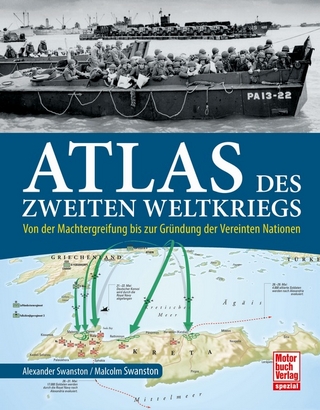
History of the de Havilland Vampire
Seiten
2017
Fonthill Media Ltd (Verlag)
978-1-78155-616-0 (ISBN)
Fonthill Media Ltd (Verlag)
978-1-78155-616-0 (ISBN)
The de Havilland Vampire was the second of the RAF's first-generation post-WWII jets. It began as an interceptor but was soon re-tasked in the day fighter/ground attack roles with the 2nd Tactical Air Force in Germany from 1948-54 and with the RAF's Middle and Far East Forces. It formed the backbone of the RAF's night-fighter force between 1952-67.
The definitive book on an iconic aircraft. Illustrated throughout with a varied and interesting selection of images, many previously unpublished. An early jet aircraft that collected many notable firsts including the first jet fighter to cross the Atlantic and the first jet to land on an aircraft carrier. Comprehensive appendices covering serial allocations, production, export details and preserved airframes. The de Havilland Vampire was the second of the RAF's first-generation, post-Second World War jet fighters to enter service. It began life as an interceptor but was soon re-tasked in the day fighter/ground attack roles with the 2nd Tactical Air Force in Germany from 1948 to 1954 and with the RAF's Middle and Far East Air Forces. Throughout its forty-six-year career, it collected many notable firsts: it was the first jet fighter to cross the Atlantic; the first jet to land on an aircraft carrier; and the first jet trainer on which student pilots qualified for their 'Wings'.
In addition to playing a full part in the RAF's order of battle during the 1940s and 1950s, the Vampire also served with the Fleet Air Arm and became an export success story for the British aircraft industry with hundreds sold to air forces worldwide. For a brief period during the 1950s, the Vampire formed the backbone of the RAF's night-fighter force and between 1952 and 1967 the Vampire trainer was responsible for a steady flow of trained pilots for the RAF, Royal Navy and foreign air forces. This comprehensive history covers the Vampire's development and operational service. It has been written with the full co-operation of the manufacturer, MoD, RAF and other world air forces, mixing narrative and technical detail with vivid personal accounts from those involved with the aircraft. Comprehensive appendices include technical specifications, production details, serials and export details. It is also lavishly illustrated and includes more than one story of encounters with UFOs by RAF Vampire pilots.
The definitive book on an iconic aircraft. Illustrated throughout with a varied and interesting selection of images, many previously unpublished. An early jet aircraft that collected many notable firsts including the first jet fighter to cross the Atlantic and the first jet to land on an aircraft carrier. Comprehensive appendices covering serial allocations, production, export details and preserved airframes. The de Havilland Vampire was the second of the RAF's first-generation, post-Second World War jet fighters to enter service. It began life as an interceptor but was soon re-tasked in the day fighter/ground attack roles with the 2nd Tactical Air Force in Germany from 1948 to 1954 and with the RAF's Middle and Far East Air Forces. Throughout its forty-six-year career, it collected many notable firsts: it was the first jet fighter to cross the Atlantic; the first jet to land on an aircraft carrier; and the first jet trainer on which student pilots qualified for their 'Wings'.
In addition to playing a full part in the RAF's order of battle during the 1940s and 1950s, the Vampire also served with the Fleet Air Arm and became an export success story for the British aircraft industry with hundreds sold to air forces worldwide. For a brief period during the 1950s, the Vampire formed the backbone of the RAF's night-fighter force and between 1952 and 1967 the Vampire trainer was responsible for a steady flow of trained pilots for the RAF, Royal Navy and foreign air forces. This comprehensive history covers the Vampire's development and operational service. It has been written with the full co-operation of the manufacturer, MoD, RAF and other world air forces, mixing narrative and technical detail with vivid personal accounts from those involved with the aircraft. Comprehensive appendices include technical specifications, production details, serials and export details. It is also lavishly illustrated and includes more than one story of encounters with UFOs by RAF Vampire pilots.
DAVID WATKINS is a former member of the RAF and a keen aviation historian with previous works including a history of RAF Chivenor, the de Havilland Vampire and Venom, 501 (County of Gloucester) Sqn, RAuxAF and a history of RAF aerobatic teams from 1920.
| Erscheinungsdatum | 27.07.2017 |
|---|---|
| Zusatzinfo | 304 black and white photographs |
| Verlagsort | Toadsmoor Road |
| Sprache | englisch |
| Maße | 172 x 248 mm |
| Gewicht | 963 g |
| Themenwelt | Natur / Technik ► Fahrzeuge / Flugzeuge / Schiffe ► Militärfahrzeuge / -flugzeuge / -schiffe |
| Sozialwissenschaften ► Politik / Verwaltung | |
| ISBN-10 | 1-78155-616-4 / 1781556164 |
| ISBN-13 | 978-1-78155-616-0 / 9781781556160 |
| Zustand | Neuware |
| Haben Sie eine Frage zum Produkt? |
Mehr entdecken
aus dem Bereich
aus dem Bereich
von der Machtergreifung bis zur Gründung der Vereinten Nationen
Buch | Softcover (2023)
Motorbuch Verlag
24,90 €


